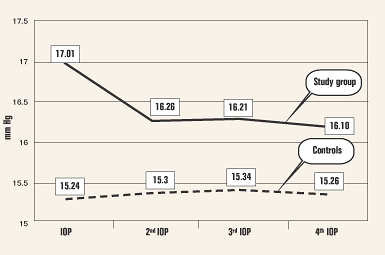Accuracy of Goldmann tonometry affected by repeated measurements, study finds
Mechanical pressure on the cornea may affect the drainage angle, causing subsequent readings to average 1 mm Hg lower.
FLORENCE – Repeated measurements of IOP in patients with glaucoma or ocular hypertension may not yield results as accurate as a good initial measurement, according to a study presented here.
Dan D. Gaton, MD, and colleagues at the Rabin Medical Center, Israel, found that nonintermittant IOP measurements made using Goldmann applanation tonometry can average 1 mm Hg less than the first measurement in patients with glaucoma or ocular hypertension.
![OSN Spotlight on Diagnostic and Test Instrumentation [logo]](/~/media/images/news/print/ocular-surgery-news-europe-asia-edition/2004/01_january/spotdiagtest_345_80_6751.gif) “Let us not forget that in these patients the accuracy of IOP is of the utmost importance because decisions regarding further treatment – namely medications, laser treatment or surgery – are made based on them,” Dr. Gaton told Ocular Surgery News.
“Let us not forget that in these patients the accuracy of IOP is of the utmost importance because decisions regarding further treatment – namely medications, laser treatment or surgery – are made based on them,” Dr. Gaton told Ocular Surgery News.
“The point of the study was to highlight that often we miss attaining a good reading for IOP, and immediately we try again. We all do this routinely,” he said.
“Our results show that immediately taken subsequent measurements may not be as accurate as a good first one, mainly in glaucoma patients. Therefore, we suggest waiting a few minutes before the next measurement is taken. This will improve accuracy of the IOP reading,” he said.
Dr. Gaton presented the results of the study at the annual meeting of the European Glaucoma Society.
Successive IOP measurements
Dr. Gaton and colleagues compared the average of each of four successive IOP measurements in a study group of 92 patients – 62 patients with primary open-angle glaucoma, 15 with pseudoexfoliation and 15 with ocular hypertension – to a control group of 50 normal patients.
Dr. Gaton noted that both groups were similar in gender and age. Patients in the control group were awaiting cataract surgery, but were otherwise healthy, he said.
According to the study, all tonometry measurements were made by the same glaucoma specialist, but were recorded by an assistant to avoid interexaminer variability. This also kept the specialist blind to the measurements and avoided the effect of the learning curve during the course of the study.
Goldmann applanation tonometry was used to measure IOP in all cases, and only one eye of each patient was included in the study. Dr. Gaton noted that all tonometries were performed with a short interval between measurements.
According to the study, a statistically significant difference in mean IOP was found between the first and fourth measurements among patients in the study group.
Mean IOP for the study group decreased from 17.01 mm Hg on the first measurement to a mean of 16.1 mm Hg on the fourth measurement (P < .001).
For the control group, mean IOP averaged around 15.3 mm Hg and did not significantly differ after any of the four measurements.
Mechanical pressure
|
According to Dr. Gaton, previous studies have noted variations in IOP with subsequent repeated measurements, with some variations as high as 5 to 6 mm Hg. Such variations have also been noted in both healthy eyes and eyes with glaucoma, he said.
In contrast, Dr. Gaton noted that in the current study only eyes with glaucoma or ocular hypertension experienced a significant and consistent decrease in IOP with repeated measurements, which may be attributable to the pathology of glaucoma, particularly in respect to the anterior chamber angle.
“One of the mechanisms in many forms of glaucoma is increased outflow resistance. It is possible that each successive application of mechanical pressure on the cornea changes the configuration of the angle, leading to a slight increase in drainage of aqueous from the anterior chamber and consequently to decline in IOP,” he said. “In normal patients, the anterior chamber angle is fully open to begin with. Thus mechanical pressure probably has no effect on IOP.”
Dr. Gaton noted that he and his colleagues suspect that any tonometers involving indentation of the cornea might generate similar results. But that remains to be investigated, he said.
“Our conclusions are that although the cumulative effect of repeated measurements on IOP is rather low – in our study approximately 1 mm Hg – it is important to remember that according to the Early Manifest Glaucoma Trial, each 1 mm Hg reduction in IOP is associated with a 10% reduction in the risk of glaucoma progression,” he said.
“Thus, according to our results, in glaucoma patients it is recommended to refer to the first IOP measurement. And if that measurement is unsuccessful, consider waiting a few minutes before repeating the procedure,” Dr. Gaton said.
For Your Information:
- Dan D. Gaton, MD, can be reached at Rabin Medical Center, Jabutinski st., Petah-Tikva 49100, Israel; 972-3-937-6108; fax: 972-3-605-0143; e-mail: gaton@post.tau.ac.il.
- Michael Piechocki is an OSN Staff Writer who covers all aspects of ophthalmology, specializing in oculoplastics. He focuses geographically on Europe and the Asia-Pacific region.

